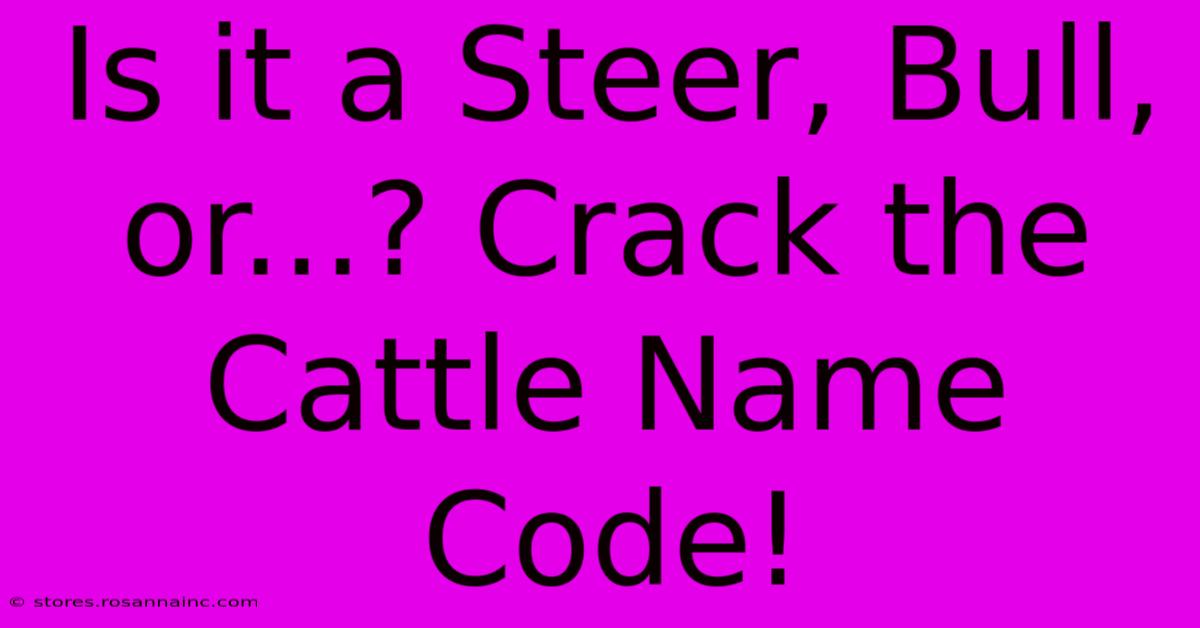Is It A Steer, Bull, Or...? Crack The Cattle Name Code!

Table of Contents
Is it a Steer, Bull, or...? Crack the Cattle Name Code!
Understanding the difference between a steer, bull, cow, heifer, and calf can be confusing, even for seasoned cattle enthusiasts. This comprehensive guide will break down the terminology, helping you confidently identify these bovine breeds. Knowing the difference is crucial, whether you're a rancher, a curious consumer, or simply interested in learning more about these magnificent animals.
Understanding Cattle Terminology: A Breakdown
Cattle classification isn't arbitrary; it's based on age, sex, and reproductive capabilities. This directly impacts their intended use and overall value.
1. The Bull:
- Definition: A mature, intact male bovine. Bulls are known for their large size, muscular build, and aggressive nature. They are the primary breeding males within a herd.
- Key Characteristics: Significant size, thick neck, prominent horns (depending on breed), aggressive behavior, and the primary role in reproduction.
- Use: Primarily used for breeding purposes to sire calves. Meat from bulls can be tough, often requiring longer cooking times, though some cuts are suitable for consumption.
2. The Steer:
- Definition: A castrated male bovine. Castration is typically performed at a young age to prevent aggressive behavior and improve meat quality.
- Key Characteristics: Similar in size to bulls but generally less aggressive. They tend to be calmer and easier to manage than bulls.
- Use: Primarily raised for beef production. Steer meat is generally more tender and flavorful than bull meat due to the absence of testosterone. This makes them the preferred choice for the beef industry.
3. The Cow:
- Definition: A mature female bovine that has given birth to at least one calf.
- Key Characteristics: Generally smaller than bulls, but still substantial in size. They are known for their maternal instincts and their role in milk production (in dairy breeds).
- Use: Primarily used for breeding and milk production (dairy cows). Beef cows also contribute to the beef supply, though often not as preferred as steers.
4. The Heifer:
- Definition: A young female bovine that has not yet given birth to a calf.
- Key Characteristics: Smaller than cows, often exhibiting a more slender build. They are typically more docile than mature cows.
- Use: Primarily raised for breeding. Heifers are carefully selected and managed to become productive breeding cows. They may also eventually contribute to the beef supply.
5. The Calf:
- Definition: A young bovine, regardless of sex, usually under one year old.
- Key Characteristics: Small size, dependent on their mother for nourishment, and a relatively docile temperament.
- Use: Calves are raised for either breeding or beef production. Veal, the meat from very young calves, is a specialized market.
Beyond the Basics: Breed Variations
The characteristics described above are general. Breed variations significantly impact size, temperament, and other traits. For instance, a Brahman bull will differ significantly in size and appearance from an Angus steer. Understanding breed specifics adds another layer to cattle identification.
Why is this information important?
Knowing the difference between these terms is vital for several reasons:
- Ranching and Agriculture: Accurate identification is crucial for herd management, breeding programs, and optimizing production.
- Consumer Awareness: Understanding the terminology helps consumers make informed choices about the beef they purchase.
- General Knowledge: Expanding your knowledge about livestock contributes to a deeper appreciation for agriculture and the food system.
This guide serves as a foundational understanding of cattle terminology. Further research into specific breeds will enhance your ability to accurately identify and differentiate various bovine animals. Now go forth and confidently crack the cattle name code!

Thank you for visiting our website wich cover about Is It A Steer, Bull, Or...? Crack The Cattle Name Code!. We hope the information provided has been useful to you. Feel free to contact us if you have any questions or need further assistance. See you next time and dont miss to bookmark.
Featured Posts
-
Beyond The Tent Peg The Real Significance Of Jaels Story
Feb 09, 2025
-
Confused About Military Ranks Discover The Warrant Officer
Feb 09, 2025
-
Connecting With Culture The Power Of The Vietnamese Flag
Feb 09, 2025
-
Vitale Receives Clemson Fan Love
Feb 09, 2025
-
Chelsea Loss Brighton Match Analysis
Feb 09, 2025
